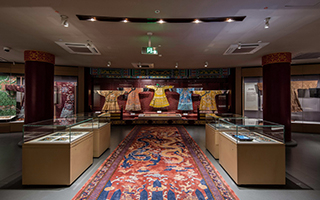Organizers
Partner
TextielMuseum, The Netherlands
WHY
Textiles are over 5000 years old and common to all civilizations, past and present. A rich and diverse living heritage that comprises a multitude of materials, techniques, and shapes. Besides being a fascinating testimony of humankind’s ingenuity, textiles provide exceptional opportunities for the heritage sector to nurture innovation, promote respect for diversity, and public engagement. Textile production, trading, and conservation are inter-related topics that bring together multiple influences and areas of knowledge, providing a valuable medium for social cohesion and promotion of sustainable development. They encompass important overlapping aspects of tangible and intangible heritage, nature and culture, traditional knowledge and state-of-the-art research. Time is ripe for rethinking how we approach textile conservation. Simply safeguarding collections can no longer be our final goal. Conservation has to grow into an effective means to promote and sustain the realization of the full potential of our textile heritage.
WHAT
The course will focus on crucial issues of values and significance, research, conservation approaches, and innovative uses of textile collections - within and beyond the heritage sector - for the common good of society. The role of museums in today’s rapidly changing world, with particular emphasis on textile heritage, will be discussed.
At the end of the course, participants will have strengthened their ability to:
- effectively assess and communicate the values and significance of textile collections;
- recognize the main textile manufacturing techniques and materials;
- comprehensively manage risks to textile collections;
- understand the scientific principles and make informed choices about materials and methods for storage, display, and conservation of textile collections;
- understand and engage the public through meaningful consultations and people-centered design of exhibitions and other activities using textile collections;
- reinterpret and reposition textile heritage to support creative industries, social sustainability, and environmental education;
- work in multidisciplinary environments within and beyond the heritage sector.
WHERE
The course will take place at the China National Silk Museum (NSM), located in the city of Hangzhou, one of the starting points of the historic Maritime Silk Road. NSM is one of the first state-level museums in China and one of the largest textile and costume museums in the world. Its main goal is to collect, research, conserve and display Chinese textiles, especially silks. It embraces both tangible and intangible dimensions of this rich heritage, and has a vibrant public outreach programme. NSM outstanding collections range from archaeo-textiles to contemporary dresses, and span multiple geographic regions. Its facilities include conservation workshops, scientific laboratories, a sericulture house, a fashion gallery, and a textile training center. This resource-rich and inspiring context will provide a conducive setting to discuss current challenges and opportunities concerning the conservation and uses of our textile heritage.
HOW
Contents will be delivered through highly interactive lectures, as well as engaging practical sessions including group work, hands-on exercises, and study visits. An interdisciplinary, multicultural course team - including NSM staff - will ensure effective communication and participation. The team will make the best possible use of the resources available at NSM for didactic purposes, including its collections and diversified facilities. Participants’ contributions will include presentation of case studies, bringing textile objects from their own context, periodical reviews, and submission of a project proposal to tackle a concrete issue related to the course topic. Keynote speeches by Chinese and international experts on a range of pertinent topics will further enrich the course experience.
WHO
Participants will be 15 students and professionals dealing with textile heritage or related subjects, being 5 from China and 10 from other countries. They should have, respectively, at least 3 years of study or experience working as collection managers, curators, conservators, scientists, exhibition designers, fashion designers, makers (crafts, weavers, dyers), cultural-policy makers, educators, creative industry developers, anthropologists, (art) historians, digital humanities.
COST
Course fee: 900 Euros
International participants will be responsible for their round trip travel costs to Hangzhou and visa expenses. The organizers will cover participants' accommodation and subsistence costs during the course. International participants with proven limited resources will be able to benefit travel grants form the ICCROM scholarship grant supported by China's National Cultural Heritage Administration.
TO APPLY
Please use the online course application form.
Please note that your personal statement is a fundamental requirement. You are expected to write approximately 500 words on: “How can we make our textile heritage a stronger tool for sustainable development, and what is the role of conservation in this?”
In order to finalize your application, the following digital files will be required when completing the online form:
- Portrait photo (allowed formats: gif jpg jpeg png tif tiff with a maximum file size of 3 MB)
- Official endorsement (allowed formats: pdf doc docx jpg jpeg png tif tiff with a maximum file size of 5 MB)
For further information, please contact textiles2020@iccrom.org



